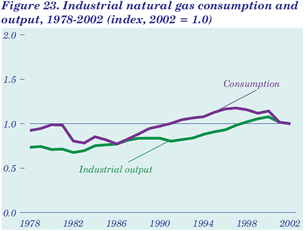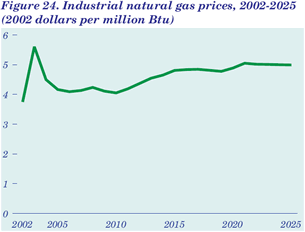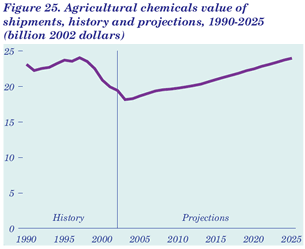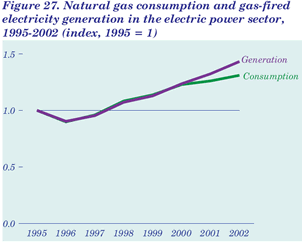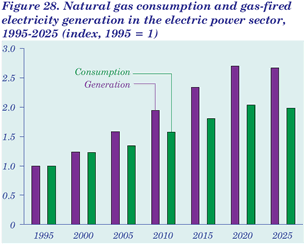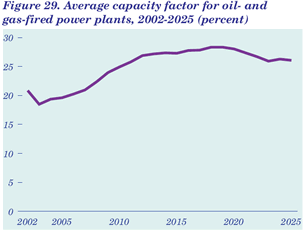|
Issues In Focus. Natural Gas Consumption in Canadian Oil Sands Production In recent years, extensive investment has gone into the development of Alberta’s oil sands. In 2002, Canada’s crude bitumen production from oil sands averaged 790,000 barrels per day, while conventional crude output was 2,140,000 barrels per day (including natural gas liquids). Natural gas is used both to extract the bitumen from the sand and to convert the bitumen into syncrude. Currently, oil sands operations consume approximately 330 billion cubic feet per year of natural gas.
Canadian oil producers have announced a number of new oil sands projects and expansions to existing oil sands facilities. The question has arisen as to whether these existing and future facilities will raise Canada’s gas consumption by a significant amount, thereby reducing the amount of Canada gas production, which is available for export to the United States. This discussion will briefly examine this issue. Most of the existing and proposed oil sands projects are located in the east-central portion of Alberta and are dispersed along a roughly north-south axis of about 200 miles in length. The Canadian oil sands consist of a mixture of sand, bitumen, and water. Based on existing facilities, and project announcements for expansions and new oil sands production facilities, EIA projects total oil sands bitumen production to be 1.7 and 3.3 million barrels per day in 2010 and 2025, respectively (Table 13). In 2010, about 52 percent of the bitumen is projected to be surface mined, and the remaining 48 percent is projected to be produced through in situ production [49]. In 2025, approximately 57 percent of the oil sands bitumen is projected to be surface mined, and 43 percent is projected to be produced through the in-situ production method. To produce synthetic crude oil, the bitumen can be either partly or totally petroleum coked or hydrocracked. Petroleum coking requires less process energy than hydrocracking and does not require a hydrogen feedstock, but 100 barrels of bitumen yields only 79 barrels of syncrude. Hydrocracking, on the other hand, requires both more process energy and a hydrogen feedstock, but 100 barrels of bitumen produces about 106 barrels of syncrude. There are three potential fuels that can be used either exclusively or in part to produce oil sands syncrude, namely, natural gas, produced bitumen, or petroleum coke, the latter of which is a process byproduct. Depending upon an oil sands facility’s design flexibility, the syncrude producer can change the slate of inputs, such as natural gas, and the slate of outputs (e.g., syncrude, petroleum coke) so as to maximize the profit margin associated with the production and upgrading of bitumen into syncrude, based on the cost/price of both the inputs and outputs. Consequently, the consumption of natural gas in these upgrading facilities is expected to change over time as relative prices change. Moreover, the input/output flexibility of any particular bitumen upgrading facility can be enhanced in the future, if prices warrant. Consequently, if natural gas prices were sufficiently high and oil prices sufficiently low, syncrude producers could theoretically eliminate natural gas consumption entirely through the exclusive use of bitumen and petroleum coke to provide the energy and feedstocks to produce and upgrade the bitumen. Carbon dioxide emissions might also play a role in determining the proportions of natural gas, bitumen, and petroleum coke used for oil sands production and processing. On December 17, 2002, Canada ratified the Kyoto Protocol, which obligates it to reduce carbon dioxide emissions to 6 percent below their 1990 level. Because petroleum coke and bitumen release more carbon dioxide when burned than natural gas does, Canada’s Kyoto Protocol obligation could limit the use of petroleum coke and bitumen in the processing of bitumen from Canadian oil sands. If natural gas were to be used exclusively to produce and convert bitumen into syncrude, then the following volumes of natural gas would be consumed to perform each of the following processes:
The natural gas consumption estimates presented in Table 13 assume that natural gas is the only energy and feedstock source for the production and upgrading of bitumen into syncrude. Table 13 assumes that the in situ production of bitumen requires 1,250 cubic feet of natural gas per barrel of bitumen. The first estimate (Case I) assumes that the bitumen is exclusively petroleum coked to create syncrude, while the second (Case II) assumes that the bitumen is exclusively hydrocracked. Of course, if oil sands producers were to extensively use bitumen and petroleum coke to provide most of the process energy and hydrogen feedstock requirements, then the actual natural gas consumed in future years would be considerably less, potentially as low as zero. In conclusion, given the potential fuel flexibility of oil sands production facilities, the question of whether Canadian oil sands production will consume significant volumes of natural gas is not easily answered. The answer to this question will depend not only on the relative prices of syncrude and natural gas, but also on the degree to which oil sands producers build fuel-flexible facilities. Consequently, the actual outcome could be as high as 1.3 trillion cubic feet per year or as low as zero. Natural Gas Consumption in the Industrial Sector Natural gas consumption in the U.S. industrial sector increased by 1.6 percent per year on average from 1990 to 2000, fell sharply in 2001, and continued to decline in 2002. During the 1990s, the industrial sector accounted for slightly less than 37 percent of total U.S. natural gas consumption, peaking in 1997 at 8.7 quadrillion Btu or 37.5 percent of the total. In the AEO2004 reference case, industrial natural gas use is projected to return to a path of steady increase after 2003, averaging 1.5-percent annual growth from 2002 to 2025 (Figure 21). Total natural gas consumption for industrial uses is projected to reach 10.6 quadrillion Btu in 2025—3.1 quadrillion Btu higher than in 2002—based on projected growth in industrial output and modestly increasing natural gas prices over the forecast period. Within the industrial sector, natural gas use for combined heat and power (CHP) applications is projected to increase by 2.6 percent per year, for feedstocks by 0.8 percent per year, and for boiler fuel and direct uses by 1.4 percent per year from 2002 to 2025 (Figure 22). With total industrial output (value of shipments) increasing by 2.6 percent annually over the same period, the natural gas intensity of industrial output in 2025 is projected to be 21 percent lower than in 2002. As a result of the economic recession that began in 2001 and the rise in natural gas prices since 2000, some industry observers have concluded that segments of the U.S. industrial sector have permanently reduced output through closures of manufacturing plants, and that the result will be a permanent reduction in demand for natural gas. Others note that similar industrial reactions to sharp increases in gas prices and to recessions are not unprecedented, and that the recent drop in demand is likely to be temporary [50] once industrial production growth resumes. A history of the recent relationship between industrial production and natural gas consumption is shown in Figure 23. In the absence of severe, multi-year recessions in the industrial sector and sustained higher prices for natural gas, it is reasonable to expect industrial output and natural gas consumption to increase in the future. AEO2004 projects little or no growth in industrial demand for coal, and most of the projected increase in demand for petroleum products is for asphalt and petroleum byproducts. Natural gas remains the fuel of choice in the industrial sector and will continue to fire most CHP applications. In the AEO2004 reference case, industrial natural gas prices are projected to rise by 1.4 percent per year on average, to $5.00 per million Btu in 2025—60 cents lower in constant 2002 dollars than the 2003 price (Figure 24). Some portions of the industrial sector, however, are especially sensitive to natural gas prices—particularly those that use natural gas as a feedstock, such as nitrogenous fertilizer production, organic chemical production, and petrochemical production. For example, 0.7 quadrillion Btu of natural gas was used for feedstocks in the chemical industry in 1998 [51], accounting for about 10 percent of total natural gas consumption in the manufacturing sector. Petroleum-based products, however, were the largest source of industrial feedstock (for organic chemicals, plastics, synthetic rubber, and petrochemicals), amounting to 3.1 quadrillion Btu, more than four times the quantity of natural gas used as a feedstock in 1998. One sector particularly sensitive to higher natural gas prices is the nitrogenous fertilizer industry. Natural gas costs account for 70 to 80 percent of the cash cost of fertilizer: production of a ton of ammonia uses 33.5 million Btu of natural gas [52]. At the average industrial natural gas price during the 1990s, the embodied cost of energy per ton of ammonia equates to about $120. At the estimated average industrial natural gas price in 2003 ($5.60 per million Btu), the embodied cost of energy is $188 per ton—a 57-percent increase. This significant increase in cost, if passed through completely, would amount to only 9.9 cents per bushel of corn, or 4 percent of the total average price of $2.35 per bushel in 2002 [53]. Large percentage increases in costs for ammonia production do not, therefore, necessarily result in proportional increases in the price of agricultural products. Higher production costs tend to be passed through quickly to the price of ammonia [54], although the amount of the pass-through can be reduced by competition from imports. Imports of ammonia historically have accounted for about 20 percent of U.S. demand. Their impact on reducing the amount of pass-through costs can, however, lag over time. The demand for natural gas as a feedstock to produce ammonia is determined largely by the quantity of ammonia produced, because petroleum-based fuels are not generally a viable economic alternative [55]. In 1998, the nitrogenous fertilizer industry consumed 338 trillion Btu of natural gas as a feedstock [56]. An additional 234 trillion Btu was consumed for process heating. In principle, the portion of the industry’s natural gas consumption used for process heating could be switched to another fuel; however, in 1994 (the most recently available data for fuel switching), the nitrogenous fertilizer industry reported that only 3.1 trillion Btu (1 percent) of its natural gas use was switchable [57]. For at least two decades, the nitrogenous fertilizer industry in the United States has been consolidating [58]. From 89 plants with an average annual capacity of 171,000 metric tons in 1970, the number of plants fell sharply after 1980, and the average capacity of the remaining plants more than doubled. In 2002 there were only 37 plants operating, with an average capacity of 451,000 metric tons. Total industry capacity in 2002, at 16.7 million metric tons, was only slightly higher than in 1970 (15.2 million metric tons). The consolidation, or even permanent closure, of nitrogenous fertilizer plants has no meaningful impact on U.S. natural gas markets, because the plants account for only a small portion of total U.S. gas consumption (0.5 quadrillion Btu out of 21.1 quadrillion Btu total in 1998). In addition, permanent closure of fertilizer plants in response to a temporary increase in natural gas prices is unlikely. For example, several producers temporarily idled their plants in the first quarter of 2002, but most of the idled capacity was back on line by the fourth quarter of the year [59]. Also, the largest U.S. producer of nitrogenous fertilizer (Farmland Industries, an agricultural cooperative), which declared bankruptcy in early 2002 [60], continued to operate most of its plants. In the AEO2004 reference case, industrial sector output is projected to grow by 2.6 percent annually from 2002 to 2025, the same growth rate experienced in the 1990s. The bulk chemical industry is projected to grow by 1.6 percent annually, slightly below its 1.8-percent growth rate during the 1990s. Agriculture is projected to grow by 1.2 percent annually, leading to a projected 0.9-percent annual growth rate for agricultural chemical production, of which nitrogenous fertilizer is a part[61]. In 2025, the value of agricultural chemical shipments is projected to be $24 billion, approximately equal to their 1997 value (Figure 25). Natural Gas Consumption for Electric Power Generation Data from EIA’s Form EIA-860 survey, “Annual Electric Generator Report,” show a dramatic increase in additions to U.S. electricity generation capacity over the past 3 years. In 2000, 2001, and 2002 more than 141 gigawatts of new generating capacity was constructed—far more than in any previous 3-year period. Virtually all of that new capacity uses natural gas as the primary fuel for electricity generation (Figure 26). Given the recent pace of capacity additions, it is not surprising that the amount of electricity produced from natural gas has increased substantially; however, natural gas consumption in the electric power sector has not increased as rapidly, because the efficiency of gas-fired generation has improved significantly (Figure 27). From 1995 to 2002, natural-gas-fired generation in the power sector increased by 43 percent, but natural gas consumption increased by only 31 percent. Notably, the gap between growth in natural-gas-fired generation and natural gas consumption by power producers began to appear in 2000, when the first wave (27 gigawatts) of the recent surge in capacity expansion occurred. The role of natural gas in the electric power sector is expected to continue growing for the foreseeable future. At the same time, the disparity between increases in gas-fired generation and in the amount of natural gas consumed by power producers is also expected to continue growing. In addition to the amount of new gas-fired generating capacity added, other factors that will affect the amount of natural gas used to generate electricity over the coming decades include: the rate of growth in electricity sales; the efficiencies of new gas-fired plants relative to those of older plants; and the price of natural gas relative to the prices of other fuels, particularly coal. Relative to the amount of generating capacity operating in 1999, additions over the 2000-2002 period amounted to an increase of 18 percent. Over the same period, electricity sales grew by only 5 percent. Consequently, many of the plants added in recent years are unlikely to be used at full capacity in the early years of their operation. Moreover, an additional 45 gigawatts of new capacity is expected to be added in 2003, all but 2 gigawatts of which will use natural gas. With growth in electricity sales expected to continue at a much more modest pace, the recent disparity between generating capacity growth and sales growth is expected to widen in the near term, and it could be many years before much of the newly added capacity is used intensively. Where new natural gas plants are used, their generation will often displace generation that would have come from older, less efficient oil- and gas-fired generators. The natural-gas-fired plants that have been added in recent years are much more efficient than older plants. For example, new combined-cycle plants have operating efficiencies between 45 and 50 percent, whereas the efficiencies of older steam plants generally are 33 percent or less. Accordingly, a new plant could generate the same amount of electricity as an older plant while consuming 27 percent less natural gas, or could use the same amount of gas as an older plant while generating 36 percent more electricity [62]. The “efficiency gap” between old and new natural-gas-fired power plants is expected to lead power companies to retire many of their older plants, because it will no longer be economical to maintain them. The newer plants, using substantially less fuel, will provide the power that the older plants were generating. In the AEO2004 reference case forecast, natural gas consumption in the electric power sector is projected to continue to increase; however, the gap between the growth in natural gas generation and natural gas consumption in the power sector is also projected to widen (Figure 28). In 2025, the amount of electricity generated from natural gas is projected to be 166 percent greater than it was in 1995, but the amount of natural gas consumed for electricity production is projected to increase by only 98 percent. Over the same period, the average efficiency of all generators using natural gas is projected to increase from 33 percent to 45 percent. Finally, in the later years of the forecast, rising natural gas prices are expected to make new coal-fired capacity economically competitive. When new coal-fired generating plants are added, they will be less expensive to operate than gas-fired plants, including those currently coming into service, and they are expected to be used for baseload generation, meeting customer needs around the clock. The capacity factor for all oil- and gas-fired capacity is projected to decline initially (Figure 29) because of the surge of capacity additions in 2002 and 2003, then rise to about 28 percent in 2018, and then decline as new coal-fired plants come on line. In the AEO2004 forecast, the end result is that natural gas consumption in the electric power sector is projected to continue growing more slowly than either additions of gas-fired capacity or generation using natural gas
.
Released: January 2004 |
||||||||||||||||||||||||||||||||||||||||||||||||||||||||||||||||||



